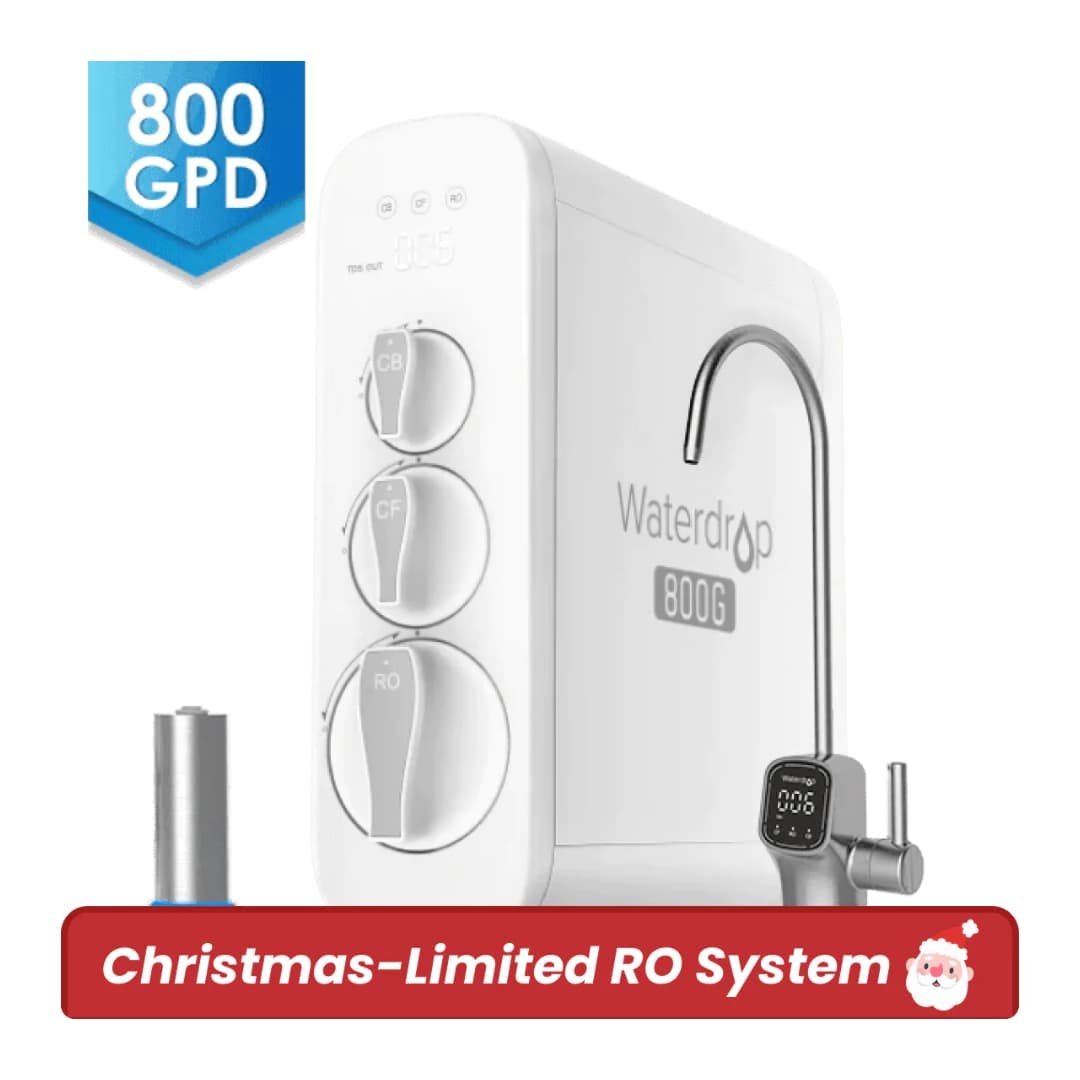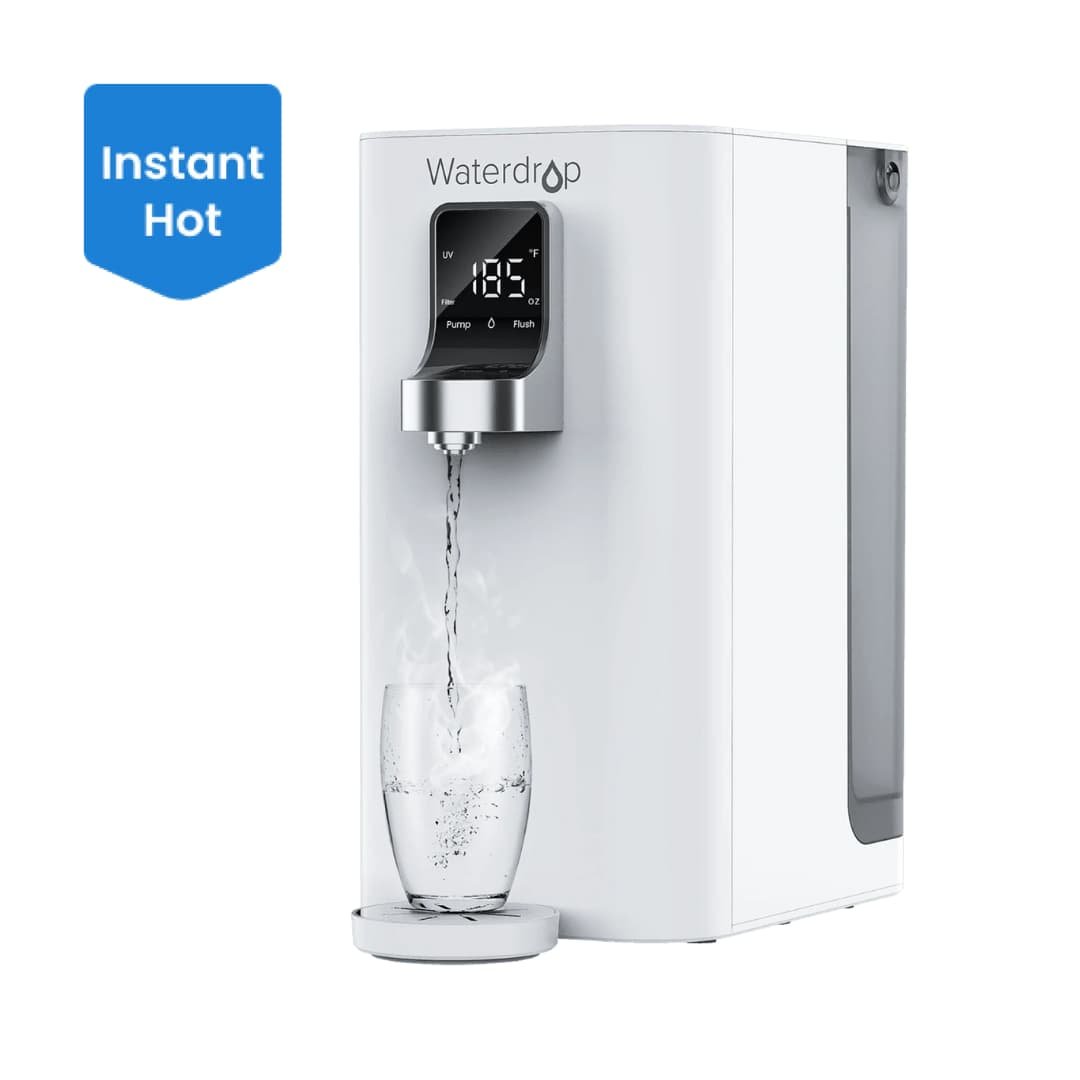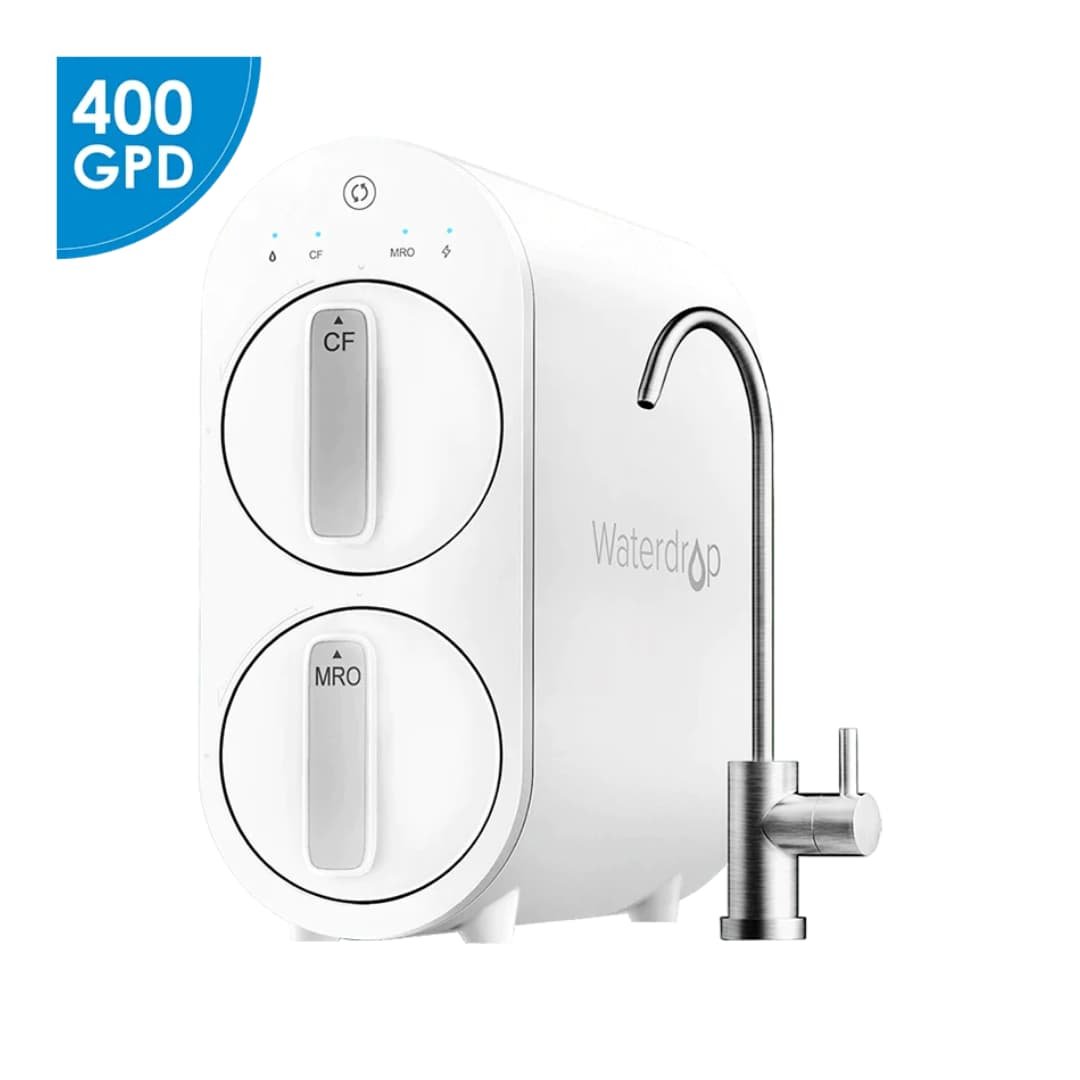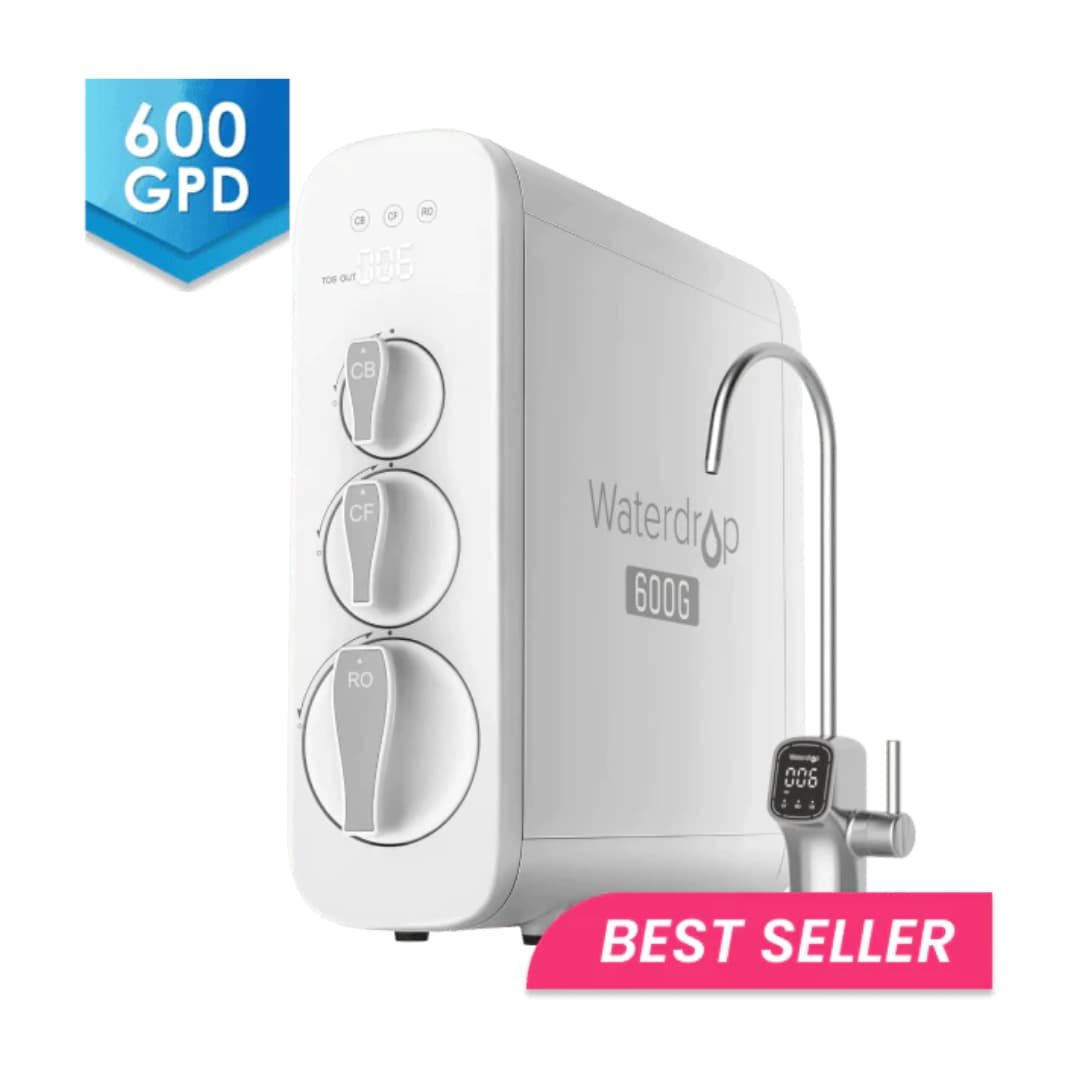Best Tankless Reverse Osmosis Filters: A Buyer's Guide
Contents Show
Tired of the taste of chlorine or the fear of lead in your tap water?
You're not alone.
The quest for clean water is a shared struggle across households.
That's why the innovation of tankless reverse osmosis systems is changing the game, offering a sip of relief.
Unlike traditional RO systems that require a bulky tank, tankless RO systems are compact, efficient, and provide a continuous supply of purified water on demand.
In this review, we'll explore the best tankless reverse osmosis systems.
Unstoppabl’s Top Picks
Waterdrop G3P800 Reverse Osmosis System: Offers a high-capacity output of up to 800 gallons per day and integrates UV filtration, along with a smart faucet featuring a TDS meter. Though premium-priced, its exceptional performance and innovative design make it a top choice
iSpring RO500AK-BN Tankless RO System: Known for its high efficiency and fast flow rate, this system includes a smart faucet with real-time water quality indicators. Its easy filter replacement and reliable water quality, coupled with TDS monitoring, make it a highly praised option
Waterdrop K19 Countertop Reverse Osmosis System: This countertop model offers a hassle-free 4-stage filtration process without the need for installation. It's ideal for those seeking portability and convenience, providing a decent water production rate and ease of use
Top Rated Tankless Reverse Osmosis Systems
When you're in the market for a tankless reverse osmosis system, you want the best.
Below, we've compiled a list of top-rated models, each with their unique features, pros, cons, and real-life user experiences.
Let's dive in and see how these systems stack up.
Waterdrop G3P800 Reverse Osmosis System
Waterdrop G3P800 Reverse Osmosis System, 800 GPD Fast Flow, NSF/ANSI 42 & 58 & 372 Certified, 3:1 Pu
- Nsf/ansi standard 42 &58 & 372 certified
- 800 gpd high-capacity
- 9-stage filtration tested by an official third-party laboratory (sgs)
- Smart faucet
- Stylish look
(Use the coupon code “Unstoppabl” to get 10% off your order when you spend over $150 on filtration systems)
A high-capacity system that produces up to 800 GPD with a sleek, integrated design.
- High daily output
- Integrated UV filtration stage
- Smart faucet with TDS meter
- Premium price point
- May require professional installation for some users
The system receives high marks for water quality and design. The cost is justified by the performance and features.
Certifications: NSF/ANSI 42 & 58 & 372.
iSpring RO500AK-BN Tankless RO Reverse Osmosis Water Filtration System
iSpring RO500AK-BN Tankless RO Reverse Osmosis Water Filtration System, 500 GPD Fast Flow with Natur
- Next generation ro system
- Superb filtration performance
- Economical and ecological choice
- 500 gpd fast water flow
- Hassle-free
The iSpring RO500AK-BN is known for its high efficiency and smart faucet that delivers real-time water quality updates.
- Fast flow rate of 0.4 gallons per minute
- Smart faucet with quality indicators
- Easy filter replacement
- Higher price point
- Requires electricity to operate
Many users praise the system for its water quality and ease of installation.
The real-time TDS monitoring is frequently highlighted as a valuable feature.
Certifications: NSF/ANSI 58 for TDS reduction and NSF/ANSI 372 for lead-free material.
Waterdrop K19 Countertop Reverse Osmosis System
- Plug and play
- V-type heating technology
- 4-stage deep filtration
- Smart design
- Saving more (3:1 drain ratio)
(Use the coupon code “Unstoppabl” to get 10% off your order when you spend over $150 on filtration systems)
Read our Waterdrop K19 Countertop Reverse Osmosis System here.
A countertop option that doesn't skimp on features, offering a 4-stage filtration process without the need for installation.
- No installation required
- Portable and convenient for various settings
- Decent water production rate
- Countertop design may not be ideal for all users
- Some reports of slower water flow compared to under-sink models
Users who prefer countertop systems rate this highly for its ease of use and maintenance.
Certifications: Not specified; check manufacturer's details for more information.
Frizzlife RO Reverse Osmosis Water Filtration System
- Remineralization & alkalization under sink water filter
- No tank design under sink reverse osmosis system
- 600 gpd high water flow
- 1.5:1 low drain ratio
- Smart led display & quick change
Read our Frizzlife RO Reverse Osmosis Water Filtration System here.
Frizzlife's system stands out with its remineralization stage and smart LED display.
- Adds beneficial minerals for alkaline water
- Low drain ratio
- Informative LED display
- Additional filter needed for remineralization
- Some users find the TDS levels inconsistent
Users appreciate the alkaline water and the system's efficiency. The LED display is also a popular feature.
Waterdrop G2 Tankless Reverse Osmosis System
- Effectively reduces most contaminants, including chlorine, heavy metals, TDS, and more
- Reduces magnesium and calcium in your tap water to the least
- The filtered soft water prolongs the lifespan of your home plumbing and improves the condition of your skin and hair
- Saves over 70% more under-sink storage space than does the ordinary RO system
- Fast water flow rate of up to 1500 liters/day
- The filters’ twist-and-pull design facilitates installation and replacement. It takes no more than 30 minutes to install and 3 seconds to replace
(Use the coupon code “Unstoppabl” to get 10% off your order when you spend over $150 on filtration systems)
This system offers a 7-stage filtration process and a 400 GPD production rate, all in a compact design.
- Space-saving tankless design
- Certified by FCC for safety
- High production rate
- Automatic flush feature can be noisy
- Some users report a complex installation process
Reviews often mention the improved water taste and the convenience of the tankless system.
The noise level during automatic flushing is noted as a minor inconvenience.
Certifications: FCC for safety and user protection.
NU Aqua 3 Stage 600GPD Undersink Tankless Reverse Osmosis Water Filter System
- Smart LED faucet
- Comprehensive 3-stage water purification
- Superior efficiency
- Quick installation & filter replacement
- Space-saving tankless design
Read our NU Aqua 3 Stage 600GPD review here.
NU Aqua offers a straightforward, efficient system with a focus on ease of installation.
- High water production rate
- Simple filter replacement
- Compact design saves space
- Only three filtration stages
- Some users report lower TDS reduction compared to other systems
The system is well-received for its user-friendly design and efficient water production.
Waterdrop G3P600 Reverse Osmosis Water Filter
- Certified against nsf/ansi
- Tested by official third-party laboratory (sgs)
- Built with a smart display faucet
- Three filters included in the package
(Use the coupon code “Unstoppabl” to get 10% off your order when you spend over $150 on filtration systems)
This model boasts a 600 GPD capacity and a 2:1 pure to drain ratio, making it an efficient choice.
- Effective 8-stage filtration
- Smart LED faucet indicator
- Low wastewater ratio
- Some users find the initial setup challenging
- The price may be a consideration for some
Positive reviews focus on the excellent water taste and the convenience of the smart faucet.
Certifications: NSF/ANSI 42 & 58 & 372.
Each of these systems has been vetted by users like you, with a focus on real-life usage and satisfaction.
Whether you prioritize capacity, ease of use, or additional features like UV filtration or remineralization, there's a tankless reverse osmosis system here that can meet your needs while adhering to safety standards and certifications.
What Are Tankless Reverse Osmosis Systems?
A tankless reverse osmosis system is a cutting-edge development in water purification technology.
Unlike traditional systems that rely on a bulky pressure tank, tankless models use on-demand filtration to provide purified water directly from the tap.
This means water passes through the RO membrane and additional filters only when you need it, not before.
The key components of these systems include a high-efficiency RO membrane, pre-filters for sediment and carbon, a post-filter, and an in-built pump that maintains water pressure.
This setup not only ensures peak functionality but also contributes to the compact design of tankless RO systems.
Why Choose a Tankless Reverse Osmosis System?
Tankless RO systems offer several advantages over their traditional counterparts.
Firstly, they save valuable under-sink space due to their compact design.
Secondly, they eliminate the risk of secondary pollution that can occur in tanks.
And they tend to have a higher water production rate, ensuring that you have access to purified water whenever you need it.
Key Features of Tankless RO Systems
When shopping for a tankless RO system, there are a few key features you should consider:
Filtration Stages: Look for systems with multiple filtration stages to ensure the highest water quality. Most top-rated systems include stages that remove sediment, chlorine, and other contaminants, as well as a reverse osmosis membrane for the finest filtration
Water Production Rate: One of the main benefits of tankless systems is their ability to produce purified water quickly. Check the gallons per day (GPD) rating to ensure the system meets your daily water usage needs
Waste Water Ratio: Efficient tankless RO systems have a low pure-to-drain ratio, meaning they waste less water compared to traditional systems
Ease of Installation and Maintenance: The best tankless RO systems are designed for easy DIY installation and maintenance. Look for systems with simple filter replacement processes and clear instructions
Certifications: Certifications like NSF/ANSI indicate that the system has been independently tested for performance and safety
Benefits of Using a Tankless Reverse Osmosis System
The benefits of a tankless reverse osmosis system are numerous.
The most obvious is the space-saving design, as these units do not require a large storage tank, making them ideal for smaller homes or apartments.
They are also more efficient, often featuring a higher water production rate and lower water waste compared to traditional RO systems.
The water quality is second to none, with these systems capable of removing a vast array of contaminants to deliver pure and clean water.
When compared to traditional systems, tankless RO systems stand out for their convenience and modern functionality.
They offer a continuous supply of fresh water, reduced risk of bacterial growth due to the absence of a tank, and often come with smart features that enhance user experience.
Main Features to Consider
When selecting a tankless reverse osmosis system, it's essential to consider several features:
Filtration Stages: More stages can mean better quality water, as each one targets different contaminants
Water Production Rate: This measures how quickly the system can produce drinking water and is crucial for meeting your daily water needs
Maintenance Requirements: Look for systems that offer easy filter changes and clear indicators of when maintenance is needed
Each feature plays a vital role in ensuring that your system meets your specific water quality needs and lifestyle.
Installation and Maintenance
Installation can vary from one model to another. Some tankless RO systems are designed for easy DIY installation, while others might require professional help.
It's important to follow the manufacturer's instructions closely or opt for professional installation to ensure the system works correctly.
Maintenance is straightforward, typically involving regular filter changes.
Many modern systems have indicators to alert you when it's time for a new filter, taking the guesswork out of maintenance.
Cost Considerations
The initial purchase price of a tankless reverse osmosis system can be higher than traditional models.
However, this cost is often offset by savings in water usage and efficiency over time.
Installation can be an additional cost, especially if professional help is needed.
Maintenance costs are generally low, involving only the periodic purchase of replacement filters.
When considering the long-term benefits of excellent water quality and convenience, many find that tankless RO systems are worth the investment.
Conclusion
Waterdrop G3P800 Reverse Osmosis System, 800 GPD Fast Flow, NSF/ANSI 42 & 58 & 372 Certified, 3:1 Pu
- Nsf/ansi standard 42 &58 & 372 certified
- 800 gpd high-capacity
- 9-stage filtration tested by an official third-party laboratory (sgs)
- Smart faucet
- Stylish look
Tankless reverse osmosis systems represent a significant advancement in water purification technology.
They offer real-time water production, space-saving designs, and energy efficiency.
With the models we've reviewed, you can expect cleaner water, ease of use, and innovative features like smart LED faucets and integrated UV filtration.
When choosing the best tankless RO system for your needs, consider factors such as water production rate, waste water ratio, filtration stages, and ease of filter replacement.
Always look for systems with reliable certifications to ensure safety and performance.
In conclusion, if you're seeking high-quality drinking water with the convenience of on-demand filtration and a modern design, a tankless RO system is a worthy investment for your home.
Frequently Asked Questions
Are Tankless Reverse Osmosis Systems Worth It?
Tankless reverse osmosis systems are considered worth it for many due to their space-saving design and efficient water purification process.
They offer quick access to purified water and eliminate the need for a storage tank, thus reducing the risk of water stagnation and bacterial growth.
Additionally, these systems are often more energy-efficient, saving on long-term costs.
What is the Most Efficient Reverse Osmosis System?
The most efficient reverse osmosis system is typically a tankless model due to its lower water wastage and energy consumption.
Tankless systems provide on-demand water purification without the need for a storage tank, ensuring fresh water with reduced waste.
They are designed to be more compact and energy-efficient, making them an excellent choice for sustainable water purification.
What is Better Than a Reverse Osmosis System?
While reverse osmosis systems are highly effective, some alternatives like ultrafiltration or distillation systems might be better in certain scenarios.
Ultrafiltration systems are effective in removing bacteria and viruses without removing essential minerals from the water, while distillation systems are excellent for removing a wide range of contaminants.
The choice depends on the specific water quality needs and personal preferences.
Is it Healthy to Drink Reverse Osmosis Water?
Drinking reverse osmosis water is generally healthy as it effectively removes contaminants, including bacteria, viruses, and chemicals.
However, the process also removes some beneficial minerals. To counteract this, many systems re-mineralize the water or users can supplement their diet with essential minerals.
It's important to ensure the system is well-maintained for optimal water quality.
Do tankless RO systems require electricity?
Yes, tankless RO systems need electricity to operate.
They use an electric pump to increase water pressure for efficient filtration.
How often do I need to change the filters in a tankless RO system?
Filter life varies by model and usage, but typically, pre-filters should be changed every 6-12 months, while the RO membrane can last 2-3 years.
Can I install a tankless RO system myself?
Many tankless RO systems are designed for DIY installation with clear instructions and videos provided by the manufacturer.
However, if you're not comfortable with the process, professional installation is recommended.
Is a tankless RO system better than a traditional one with a tank?
Tankless RO systems are more compact, have a faster water flow rate, and reduce the risk of secondary pollution.
However, they tend to be more expensive upfront.
How much water do tankless RO systems waste?
Tankless RO systems are more efficient, with some models boasting a pure-to-drain ratio as low as 1:1, meaning for every gallon of purified water, only one gallon is wasted.







